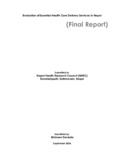

Please use this identifier to cite or link to this item: https://hdl.handle.net/20.500.14356/367
| Title: | Evaluation of Essential Health Care Delivery Services in Nepal |
| Authors: | Nepal Health Research Council (NHRC) Devkota, Bhimsen |
| Issue Date: | 2006 |
| Publisher: | Nepal Health Research Council |
| Keywords: | Essential Health Care Delivery |
| Abstract: | The Background of the Study: Despite the gains in key health indicators over the past 15 years, such as in reduction of child mortality rate (40%) and fertility rate (20%), poor public health interwoven with poverty still pose a challenge in Nepal's efforts to poverty reduction. Poverty and poor health compounded with inequitable distribution of resources, non-responsiveness to citizen voice and sustained exclusion of the excluded from accessing the public services have long been considered as the impediments in Nepal's realization of the overall health sector goals including the development goals. The government's commitments to bridge the gap between the haves and the haves not through improved and equitable allocation of resources, increased empowerment, inclusion and partnership have been expressed in its various policy papers like Poverty Reduction Strategy Paper(PRSP), Agenda for Reform (2004), Health Sector Programme Implementation Plan (2003), the Local Self Governance Act (1998), Medium Term Expenditure Framework (2002), Millennium Development Goals (MDGs) and the current development plans. The Ministry of Health and Population (MoHP) aims to achieve ‘a health system in which there is equitable access to coordinated quality health care services in rural and urban areas, characterized by self-reliance, full community participation, decentralization, gender sensitivity, effective and efficient management and private and non-governmental organization (NGO) sector participation in the provision and financing of health services resulting in improved health status of the population.’ MoHP recently issued a new Health Sector Strategy: An Agenda for Reform in 2004, with the objective of ‘meeting the health and welfare needs of all, especially the poor, women and other vulnerable groups.’ The new health sector reform strategy summarizes eight areas for key reforms and outputs, directly pertaining to how the country can better meet the challenge of health needs, especially among poor and disadvantaged groups, and women.These include: (a) ensuring universal access to essential health care services using cost-effective interventions; (b) establishing public-private NGO partnerships to delivery quality health care services; (c) decentralizing the health system for fair and efficient delivery; (d) obtaining better value for health expenditure through pre-paid alternative health financing mechanisms; (e) providing access to services outside of health care facilities and (f) monitoring health sector performance through logical frameworks. The recently formulated National Health Sector Programme – Implementation Plan (2003-2007) based on the Second Long Term Health Plan (1997-2017), encourages a move away from project towards a more programmatic, sector-wide approach, in order to deliver health services in a more sustainable and equitable manner. |
| URI: | http://103.69.126.140:8080/handle/20.500.14356/367 |
| Appears in Collections: | NHRC Research Report |
Files in This Item:
| File | Description | Size | Format | |
|---|---|---|---|---|
| 498.pdf | Full Text. Download | 2.72 MB | Adobe PDF |  View/Open |
Items in DSpace are protected by copyright, with all rights reserved, unless otherwise indicated.
Theme by
DSpace Software Copyright © 2024 Maintained by Chandra Bhushan Yadav, Library & Information Officer, NHRC. - Feedback